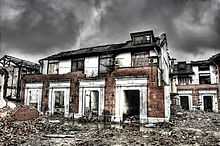Shikumen



Shikumen (Chinese: t 石庫門, s 石库门, p shíkùmén, lit. "Stone Warehouse Gate") is a traditional Shanghainese architectural style combining Western and Chinese elements that first appeared in the 1860s.[1] At the height of their popularity, there were 9000 shikumen-style buildings in Shanghai, comprising 60% of the total housing stock of the city,[2] but today the proportion is much lower as most Shanghainese live in large apartment buildings.
Structure
Shikumens are two- or three-story structures resembling Anglo-American terrace houses or townhouses, distinguished by high brick walls enclosing a narrow front yard. The name "stone gate" references these strong gateways.
Each residence abuts another and all are arranged in straight side alleys called longtang (Chinese: t 挵堂, s 弄堂, p lòngtáng; Shanghainese: longdang). The entrance to each alley is usually surmounted by a stylistic stone arch.
The shikumen is a cultural blend of the elements found in Western architecture[citation needed] with traditional Lower Yangtze architecture and social behavior. Traditional Chinese dwellings had a courtyard, and the Shikumen was no exception. Yet, to compromise with its urban nature, its was much smaller and provided an interior haven to the commotions in the streets, allowing for raindrops to fall and vegetation to grow freely within a residence. The courtyard also allowed sunlight and improved ventilation into the rooms.
History
This style of housing originally developed when local developers adapted Western-style terrace houses to Chinese conditions.[citation needed] The wall was added to protect against fighting and looting during the Small Swords Rebellion and proved useful against later burglars and vandals during the social upheavals of the early twentieth century. By World War II, more than 80% of the population in the city lived in these kinds of dwellings. Many of these were hastily built in slum conditions, while others were of sturdy construction and featured all modern amenities such as running water and flushing toilets.
During and after World War II, massive population increases in Shanghai led many shikumen houses to be heavily subdivided. For example, the spacious living room was often divided into three or four rooms, each lent out to a separate family. These cramped conditions continue to exist in many of the shikumen districts that have survived recent development of the Reform and Opening period.
The landlords who sublet the shikumens out to other families were called "second landlords" (二房东, èr fángdōng), as opposed to their primary owners (大房东, dà fángdōng). Such "second landlords'" families often shared the same shikumen building with the tenants.[citation needed]
See also
External links
References
- ↑ Goldberger, Paul (2005-12-26). "Shanghai Surprise: The radical quaintness of the Xintiandi district.". The New Yorker.
- ↑ "History of Shikumen". Eastday.
| |||||||||||||||||||||||||||||||||||||||||||||||||||||||